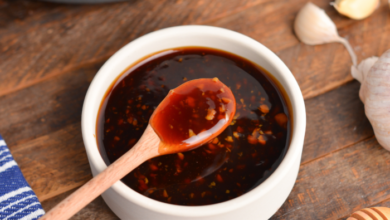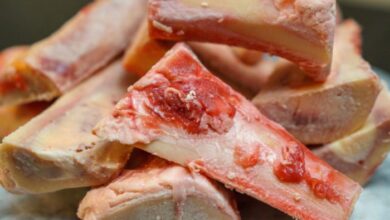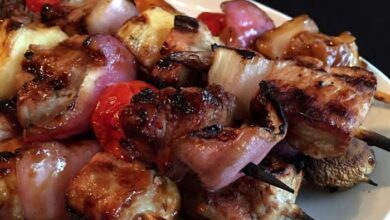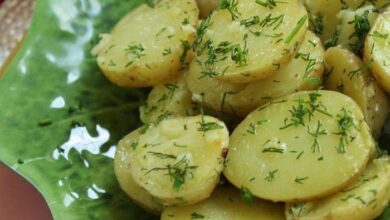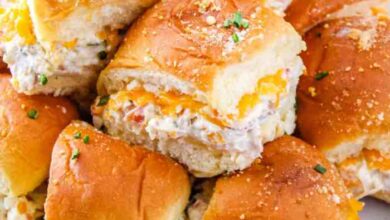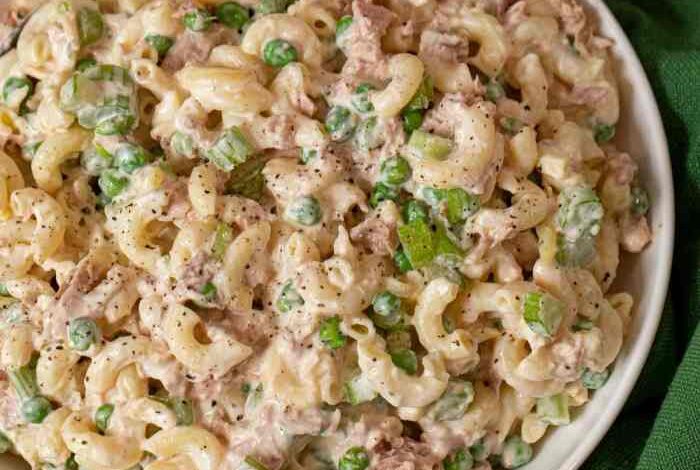
Tuna Pasta Salad with Dill: A Classic Recipe
Tuna pasta salad with dill is a classic dish that has been enjoyed by people all over the world for decades. It’s a simple, yet versatile recipe that can be customized to suit any taste. The combination of tuna, pasta, and dill creates a flavor profile that is both refreshing and satisfying.
Whether you’re looking for a light lunch, a side dish for a barbecue, or a quick and easy dinner, tuna pasta salad is a great option.
This post will delve into the history, ingredients, preparation, and serving of tuna pasta salad with dill. We’ll explore the different variations of this recipe, including those incorporating various cheeses, vegetables, and dressings. We’ll also discuss the nutritional aspects of this dish and provide tips for making it healthier.
Join me as we uncover the secrets of this beloved culinary classic!
Tuna Pasta Salad
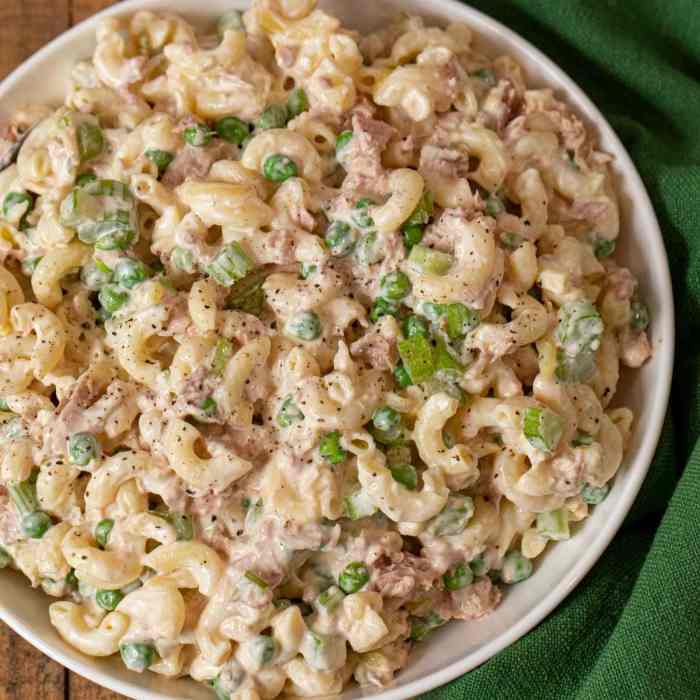
Tuna pasta salad is a classic dish that is enjoyed by people of all ages. It is a simple and versatile dish that can be customized to suit any taste. The origins of tuna pasta salad are somewhat unclear, but it is believed to have originated in the United States in the mid-20th century.
It is a popular dish for potlucks, picnics, and summer gatherings.
The Cultural Significance of Tuna Pasta Salad
Tuna pasta salad has become a staple dish in many cultures around the world. It is a popular dish in the United States, Canada, Australia, and the United Kingdom. In the United States, tuna pasta salad is often served at potlucks, picnics, and summer gatherings.
It is also a popular dish for school lunches and work lunches. In other countries, tuna pasta salad may be served as a main course or as a side dish.
The Evolution of Tuna Pasta Salad Recipes
Tuna pasta salad recipes have evolved over time. Early recipes for tuna pasta salad were often simple, consisting of just tuna, pasta, mayonnaise, and celery. However, over time, recipes have become more complex, with the addition of ingredients such as onions, peppers, olives, and herbs.
The following timeline highlights the evolution of tuna pasta salad recipes:
- 1950s:The first tuna pasta salad recipes appeared in American cookbooks. These recipes were typically simple, consisting of tuna, pasta, mayonnaise, and celery.
- 1960s:Tuna pasta salad recipes began to include more ingredients, such as onions, peppers, and olives. These recipes were often served at potlucks and picnics.
- 1970s:Tuna pasta salad recipes became more elaborate, with the addition of herbs, spices, and other ingredients. These recipes were often served as a main course.
- 1980s:Tuna pasta salad recipes began to incorporate different types of pasta, such as rotini, penne, and farfalle.
- 1990s:Tuna pasta salad recipes became more health-conscious, with the addition of ingredients such as low-fat mayonnaise and whole-wheat pasta.
- 2000s:Tuna pasta salad recipes continued to evolve, with the addition of new ingredients and flavor combinations. These recipes are often inspired by cuisines from around the world.
Ingredients and Variations
Tuna pasta salad is a versatile dish that allows for endless creativity in terms of ingredients and flavor combinations. The basic recipe typically features tuna, pasta, mayonnaise, and vegetables, but there’s a world of possibilities to explore beyond these staples.
Common Ingredients and Substitutions
A table outlining common ingredients and their substitutions provides a comprehensive overview of the ingredients used in tuna pasta salad.
Tuna pasta salad with dill is a classic for a reason – it’s light, refreshing, and perfect for a potluck or picnic. But sometimes, you want something a little heartier, and that’s where Colleen’s slow cooker jambalaya comes in. The smoky sausage, tender chicken, and spicy rice are sure to satisfy.
And if you’re feeling adventurous, you can even add some of the leftover tuna pasta salad to your jambalaya for a unique twist!
| Ingredient | Quantity | Substitutions |
|---|---|---|
| Tuna | 1 (5 ounce) can | Chicken, chickpeas, or tofu |
| Pasta | 1 cup cooked | Any type of pasta, such as elbow macaroni, rotini, or penne |
| Mayonnaise | 1/2 cup | Greek yogurt, sour cream, or a combination of both |
| Celery | 1/2 cup chopped | Red onion, cucumber, or bell pepper |
| Onion | 1/4 cup chopped | Shallot, chives, or green onions |
| Dill | 1 tablespoon chopped | Parsley, chives, or tarragon |
| Salt and pepper | To taste |
Visual Representation of a Typical Tuna Pasta Salad Recipe
Imagine a bowl filled with a vibrant mix of ingredients. At the center, nestled amongst the other components, lies a mound of cooked pasta, its shape and size varying depending on the type used. Scattered throughout are chunks of tuna, their pale flesh contrasting with the bright green of chopped celery and the vibrant red of diced tomatoes.
A sprinkle of finely chopped onion adds a touch of sharpness, while a generous helping of mayonnaise binds the ingredients together, creating a creamy and cohesive texture. Finally, a generous sprinkling of fresh dill adds a burst of herbaceous flavor, its delicate green leaves contrasting with the other colors in the bowl.
The Role of Dill in Tuna Pasta Salad, Tuna pasta salad with dill
Dill, with its bright, citrusy, and slightly anise-like flavor, adds a refreshing and aromatic touch to tuna pasta salad. It complements the richness of the mayonnaise and tuna, while also providing a subtle contrast to the other ingredients. The delicate flavor of dill enhances the overall taste of the salad, making it more complex and flavorful.
Tuna pasta salad with dill is a classic for a reason – it’s light, refreshing, and perfect for a summer picnic. But sometimes, I crave something a little more savory and satisfying. That’s when I turn to a dish like cashew chicken with water chestnuts , with its sweet and tangy sauce and crunchy texture.
After a hearty serving of cashew chicken, I always find myself appreciating the simple, cool flavors of tuna pasta salad even more.
Popular Variations of Tuna Pasta Salad
Tuna pasta salad offers endless possibilities for customization. Here are some popular variations that showcase the versatility of this dish:* Cheesy Variations:Adding cheese, such as cheddar, Monterey Jack, or crumbled feta, can add a creamy and salty dimension to the salad.
Vegetable Variations
Tuna pasta salad with dill is a classic for a reason – it’s light, refreshing, and perfect for picnics or potlucks. But sometimes you crave something a bit more indulgent, and that’s where those easy cheesy hot dog crescent rolls come in! They’re a fun and cheesy treat that pairs perfectly with the cool, tangy flavors of the tuna salad.
So, next time you’re planning a meal, why not try both? You’ll have a delicious and satisfying spread for everyone to enjoy.
Incorporating different vegetables, such as bell peppers, carrots, broccoli florets, or black olives, adds color, texture, and nutritional value.
Dressing Variations
Experimenting with different dressings, such as lemon vinaigrette, ranch dressing, or a mustard-based dressing, can create a unique flavor profile.
Preparation and Cooking Techniques
Tuna pasta salad is a simple dish that can be prepared in a variety of ways. The key to a successful tuna pasta salad is to use fresh, high-quality ingredients and to pay attention to the timing and ratios of the ingredients.
This will ensure that the salad is flavorful, refreshing, and satisfying.
Step-by-Step Guide for Preparing Tuna Pasta Salad
Preparing tuna pasta salad is a straightforward process that involves a few simple steps.
- Cook the pasta:Start by cooking the pasta according to the package directions. It is essential to cook the pasta al dente, which means that it should be firm to the bite. Overcooked pasta will become mushy and will not hold its shape in the salad.
- Prepare the tuna:While the pasta is cooking, prepare the tuna. If you are using canned tuna, drain it and flake it with a fork. If you are using fresh tuna, grill or pan-fry it until it is cooked through.
- Combine the ingredients:Once the pasta is cooked and drained, transfer it to a large bowl. Add the tuna, mayonnaise, dill, celery, red onion, and any other desired ingredients. Toss the ingredients together gently until they are well combined.
- Chill the salad:Cover the bowl and refrigerate the salad for at least 30 minutes before serving. This will allow the flavors to meld and the salad to chill.
Tips and Tricks for Achieving the Perfect Texture and Flavor in Tuna Pasta Salad
There are a few simple tips and tricks that can help you achieve the perfect texture and flavor in your tuna pasta salad.
- Use high-quality ingredients:The quality of the ingredients will directly impact the flavor of your salad. Use fresh, high-quality tuna, mayonnaise, and vegetables.
- Adjust the mayonnaise:The amount of mayonnaise you use will determine the consistency of your salad. Start with a small amount of mayonnaise and add more as needed to achieve the desired consistency.
- Don’t overmix:Overmixing the salad will cause the pasta to break down and the vegetables to become mushy. Toss the ingredients gently until they are just combined.
- Season to taste:Once the salad is assembled, taste it and adjust the seasoning as needed. Add salt, pepper, lemon juice, or other seasonings to enhance the flavor.
Importance of Proper Ingredient Ratios and Timing in Tuna Pasta Salad Preparation
The ratios of the ingredients in tuna pasta salad are important for achieving a balanced flavor and texture.
A good rule of thumb is to use a 1:1 ratio of pasta to tuna.
The timing of the ingredients is also important. The pasta should be cooked al dente, and the tuna should be prepared according to the recipe.
If the tuna is overcooked, it will become dry and tough.
Compare and Contrast Different Methods of Cooking Pasta for Tuna Pasta Salad
There are a few different methods for cooking pasta for tuna pasta salad.
- Boiling:Boiling is the most common method for cooking pasta. It is a simple and straightforward method that produces cooked pasta with a soft texture.
- Baking:Baking pasta is a less common method, but it can be used to create a more flavorful pasta. Baking the pasta in the oven allows the pasta to absorb the flavors of the other ingredients in the salad.
- Grilling:Grilling pasta is a unique method that adds a smoky flavor to the pasta. Grilling the pasta can be done on a gas or charcoal grill.
Serving and Presentation
Tuna pasta salad is a versatile dish that can be enjoyed in many different ways. It’s a great option for potlucks, picnics, or even a casual weeknight dinner. Here are some creative ways to serve and present your tuna pasta salad to make it even more appealing:
Serving Suggestions
Tuna pasta salad is a great option for a casual lunch or dinner, and it can be served in a variety of ways. Here are some serving suggestions:
- Individual portions: Serve tuna pasta salad in individual bowls or cups. This is a great option for potlucks or picnics.
- Large bowl: Serve tuna pasta salad in a large bowl for a family-style meal.
- On bread: Serve tuna pasta salad on bread, crackers, or chips for a more substantial meal.
Garnishes and Side Dishes
Adding garnishes and side dishes can elevate your tuna pasta salad and create a more complete and visually appealing meal.
- Garnishes: To add color and texture, consider garnishing your tuna pasta salad with fresh herbs like dill, parsley, or chives, a sprinkle of paprika, or a few lemon wedges.
- Side Dishes: Pair your tuna pasta salad with a side dish like a green salad, fruit salad, or a simple bread roll for a well-rounded meal.
Plating for Visual Appeal
Presentation matters! A visually appealing plate can enhance the enjoyment of your tuna pasta salad.
- Color Contrast: Use contrasting colors in your garnishes to create a visually appealing plate. For example, you can use red tomatoes, green lettuce, and yellow bell peppers to add pops of color.
- Height and Texture: Add height to your plate by using a small bowl or ramekin to serve the tuna pasta salad. You can also add texture by topping it with toasted nuts, croutons, or chopped vegetables.
- Clean and Simple: Keep your plate clean and simple. Don’t overcrowd the plate with too many ingredients.
Incorporating Tuna Pasta Salad into Different Meals and Events
Tuna pasta salad is a versatile dish that can be incorporated into various meals and events.
- Potlucks and Picnics: Tuna pasta salad is a great option for potlucks and picnics as it is easy to transport and serve.
- Casual Lunches and Dinners: Serve tuna pasta salad as a main course or a side dish for a casual lunch or dinner.
- Buffet-Style Meals: Tuna pasta salad is a great option for buffet-style meals.
Storing and Reheating
Tuna pasta salad can be stored in the refrigerator for up to 3 days. It is best to store it in an airtight container to prevent it from drying out.
- Reheating: Tuna pasta salad can be reheated in the microwave or on the stovetop.
Nutritional Considerations: Tuna Pasta Salad With Dill
Tuna pasta salad, a beloved dish for its convenience and flavor, can be a part of a balanced diet when prepared mindfully. Understanding its nutritional profile and making informed choices can help you enjoy this dish while maintaining your health goals.
Nutritional Profile of Tuna Pasta Salad
The nutritional content of tuna pasta salad can vary greatly depending on the specific ingredients used and the portion size. However, a typical recipe often includes ingredients like tuna, pasta, mayonnaise, vegetables, and seasonings.
- Tuna:A good source of protein, omega-3 fatty acids, and selenium.
- Pasta:Primarily carbohydrates, providing energy. The type of pasta used can impact its nutritional value.
- Mayonnaise:High in fat and calories, mainly from unhealthy saturated and trans fats.
- Vegetables:Contribute vitamins, minerals, and fiber.
- Seasonings:Typically low in calories but can add sodium and other additives.
Health Benefits of Tuna Pasta Salad
Tuna pasta salad can offer some health benefits, primarily due to the tuna and vegetables:
- Protein:Tuna provides a good source of protein, essential for building and repairing tissues, and supporting muscle growth.
- Omega-3 Fatty Acids:Tuna is rich in omega-3 fatty acids, which are beneficial for heart health, brain function, and reducing inflammation.
- Vitamins and Minerals:Vegetables in the salad contribute essential vitamins and minerals like vitamin C, vitamin K, potassium, and folate.
Potential Drawbacks of Tuna Pasta Salad
While tuna pasta salad can be a nutritious option, it’s important to be aware of potential drawbacks:
- High in Fat and Calories:Mayonnaise is a high-fat ingredient, making the salad calorie-dense.
- Sodium Content:Some seasonings and processed ingredients can add significant sodium, contributing to high blood pressure.
- Mercury Levels in Tuna:Tuna, especially albacore tuna, can contain mercury, a heavy metal that can be harmful in high amounts, particularly for pregnant women and young children.
Making Tuna Pasta Salad Healthier
To make tuna pasta salad a healthier choice, consider these tips:
- Use Whole Grain Pasta:Whole grain pasta is higher in fiber, which promotes satiety and aids digestion.
- Reduce Mayonnaise:Use less mayonnaise or substitute it with Greek yogurt, avocado, or hummus for a lower-fat option.
- Incorporate More Vegetables:Increase the amount of vegetables in the salad to add volume, fiber, and nutrients.
- Choose Light Tuna:Opt for light tuna, which typically has lower mercury levels than albacore tuna.
- Season with Herbs and Spices:Use fresh herbs and spices to add flavor without adding extra calories or sodium.
Lighter and More Nutritious Tuna Pasta Salad Variations
Here are some lighter and more nutritious variations of tuna pasta salad:
- Greek Tuna Pasta Salad:Use whole grain pasta, light tuna, Greek yogurt, cucumber, tomatoes, red onion, and fresh dill for a tangy and refreshing salad.
- Asian-Inspired Tuna Pasta Salad:Combine whole grain pasta, light tuna, shredded carrots, edamame, chopped celery, and a light sesame-ginger dressing for a flavorful and healthy option.
- Mediterranean Tuna Pasta Salad:Use whole grain pasta, light tuna, chopped Kalamata olives, feta cheese, artichoke hearts, and a lemon vinaigrette for a flavorful and Mediterranean-inspired salad.

